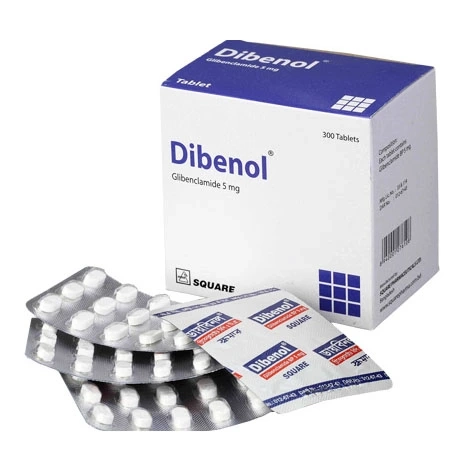Unit Price:
৳ 0.35
(20 x 15: ৳ 105.00)
Strip Price:
৳ 5.25
Indications
Dibenol is indicated as an adjunct to diet and exercise to improve glycemic control in adults with type 2 diabetes mellitus.
* রেজিস্টার্ড চিকিৎসকের পরামর্শ মোতাবেক ঔষধ সেবন করুন
Pharmacology
Glibenclamide appears to lower the blood glucose acutely by stimulating the release of insulin from the pancreas, an effect dependent upon functioning beta cells in the pancreatic islets. The mechanism by which Glibenclamide lowers blood glucose during long-term administration has not been clearly established. With chronic administration of Glibenclamide in Type 2 diabetic patients, the blood glucose lowering effect persists despite a gradual decline in the insulin secretory response to the drug. In addition to its blood glucose lowering actions, Glibenclamide produces a mild diuresis by enhancement of renal free water clearance.
Dosage & Administration
There is no fixed dosage regimen for the management of diabetes mellitus with Glibenclamide or any other hypoglycemic agent. The usual starting dose of Glibenclamide as initial therapy is 2.5 to 5 mg daily, administered with breakfast or the first main meal.Those patients who may be more sensitive to hypoglycemic drugs should be started at 1.25 mg daily.The usual maintenance dose is in the range of 1.25 to 20 mg daily, which may be given as a single dose or in divided doses. Dosage increases should be made in increments of no more than 2.5 mg at weekly intervals based upon the patient's blood glucose response. Daily doses of more than 20 mg are not recommended.
* রেজিস্টার্ড চিকিৎসকের পরামর্শ মোতাবেক ঔষধ সেবন করুন
Interaction
The hypoglycemic action of sulfonylureas may be potentiated by certain drugs including nonsteroidal anti-inflammatory agents, ACE inhibitors, fluoxetine, clarithromycin, and other drugs that are highly protein bound, salicylates, sulfonamides, chloramphenicol, probenecid, monoamine oxidase inhibitors, and beta adrenergic blocking agents. When such drugs are administered to a patient receiving Dibenol, the patient should be observed closely for hypoglycemia. When such drugs are withdrawn from a patient receiving Dibenol, the patient should be observed closely for loss of control. A potential interaction between oral miconazole and oral hypoglycemic agents leading to severe hypoglycemia has been reported. Certain drugs tend to produce hyperglycemia and may lead to loss of control. These drugs include the thiazides and other diuretics, corticosteroids, phenothiazines, thyroid products, estrogens, oral contraceptives, phenytoin, nicotinic acid, sympathomimetics, calcium channel blocking drugs, and isoniazid.
Contraindications
Glibenclamide is contraindicated in patients:
- With known hypersensitivity to the drug or any of its excipients.
- With type 1 diabetes mellitus or diabetic ketoacidosis, with or without coma. These conditions should be treated with insulin.
Side Effects
Severe hypoglycemic reactions with coma, seizure, or other neurological impairment occur infrequently.
Pregnancy & Lactation
Pregnancy Category C. There is no information on the use of Glibenclamide in human pregnancy but it has been in wide, general use for many years without apparent ill consequence. Animal studies have shown no hazard. It has not yet been established whether Glibenclamide is transferred to human milk. However, other sulphonylureas have been found in milk and there is no evidence to suggest that Glibenclamide differs from the group in this respect.
Precautions & Warnings
All sulfonylurea drugs are capable of producing severe hypoglycemia. Proper patient selection, dosage, and instructions are important to avoid hypoglycemic episodes.
Therapeutic Class
Sulfonylureas
Storage Conditions
Store below 30°C, protected from light and moisture. Keep all medicines out of reach of children.

